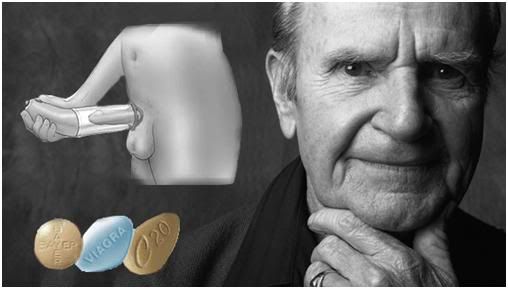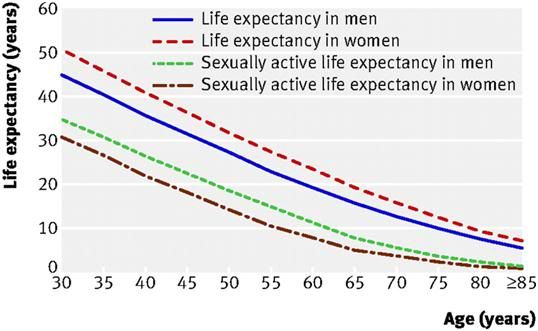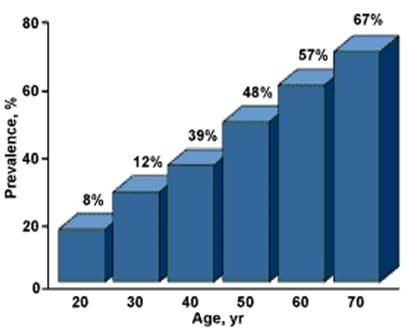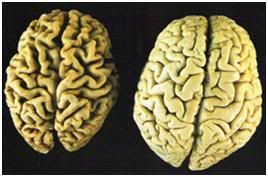 By Mike Darwin
By Mike Darwin
Sex and Aging
It is so common place as to be almost axiomatic. The ‘rake’ or ‘slut’ who, in middle or old age, has become not merely transformed into a moralistic prude, but is completely unable to remember what it was like to be young and horny. For those of you who are young (under 40) and reading this, the full impact of what I’m saying here will be lost. That’s because you have to see this transformation in your cohorts and in your own lovers and spouses to believe it – let alone to really appreciate it.
How is it that people who once reveled in the joys of sex and even pushed or went well beyond the boundaries of permissible so uniformly become transformed into little ladies of either sex? Is it bad experiences? Is it improved social station and the respectability that often accompanies it? Mostly the answer to these questions is, “No, it is none of these things so much as it is the biology of the aging brain.”
 Figure 1: How is it that what both men and women once reveled in and found unspeakably beautiful in youth, they regard with indifference or even revulsion in middle and old age?
Figure 1: How is it that what both men and women once reveled in and found unspeakably beautiful in youth, they regard with indifference or even revulsion in middle and old age?
As Robert Ettinger wisely observed, “a great many people have to be coaxed into admitting that life is better than death, healthy is better than sick, smart is better than stupid, and immortality might be worth the trouble! [1] So far, we cryonicists have not managed to find any particularly successful strategy for achieving those ends. Perhaps we should take a leaf from how successful marketing and propaganda work in most other spheres of human activity, ranging from commerce to religion, principally that sex sells.
The Big Business of Sex: Implications for Cryonics & Immortalism?
It has been estimated that the pornograophy industry in the US was a ~12 billion dollar industry in 2003. (http://www.pbs.org/wgbh/pages/frontline/shows/porn/interviews/mcalpine.html). In 2005 the national sales of the guanyl cyclase inhibitor anti-impotence drugs, such as Viagra® were reported to be $1.6 billion, Cialis® sales were $747 million and Levitra® sales were $327 million. That’s over $2 billion dollars and it does not include the cost outlay for OTC products such as Extenz, nor for mechanical aids such penile vacuum pumps and surgical interventions. A conservative estimate is that today the sex assistance business is well in excess of $5 billion per year – and that is just in the US. If the aggregate of all sexually based marketing is considered then the figure is possibly in excess of $100 billion per annum. Thus, it is hard to argue that sex doesn’t sell.
Sexual Mortality: the Data Speak
In talking with people, young and old, about their personal sexual futures, a striking common thread emerges: virtually all of the subjects I interviewed anticipated that they would experience fairly constant, or at best mild to moderate reductions in their sexual performance with aging. In fact, nothing could be further from the truth. So called “normal healthy aging” kills sex. The sexual death rate, even amongst healthy individuals in highly developed countries, is astonishingly high. Just how bad is it? Well take a look at the graph in Figure 2, below.
 Figure 2: The data above reflect the real, measured life expectancy and sexually active life expectancy inUS men and women based on data from a national survey of midlife development in the United States (MIDUS). Lindau, ST, Gavrilova,N. Sex, health, and years of sexually active life gained due to good health: evidence from two US population based cross sectional surveys of ageing BMJ 2010; 340:c810: http://www.bmj.com/content/340/bmj.c810.full
Figure 2: The data above reflect the real, measured life expectancy and sexually active life expectancy inUS men and women based on data from a national survey of midlife development in the United States (MIDUS). Lindau, ST, Gavrilova,N. Sex, health, and years of sexually active life gained due to good health: evidence from two US population based cross sectional surveys of ageing BMJ 2010; 340:c810: http://www.bmj.com/content/340/bmj.c810.full
As can be seem from the data, on average, you have about as much chance of being sexually functional (let alone functional at the level you were in your teens or 20s) at age 55 or 60, as you would have had of living to age 75 in 1800 (the mean lifespan was ~40 years then).
 Figure 3: Decline in sexual function compared with decline in cognitive function in normal, healthy human aging.
Figure 3: Decline in sexual function compared with decline in cognitive function in normal, healthy human aging.
What surprises those to whom I show the data in Figure 3, above, is that sexual mortality occurs much earlier than does the loss of cognitive function. This isn’t really surprising when considered in the context of evolutionary biology. Selection pressure has optimized human reproduction to occur in the early teens to mid-20s. Reproduction in females would typically begin almost immediately after menses commenced, at age 13-14, and it was complete typically before menopause, which occurred in earlier generations at ~ 40-45 years of age. Men can (and do) reproduce longer, and their sexual viability curve reflects this. Why women have a significantly shorter sexual lifespan than men is not known with certainty, but the evolutionary biology of the female reproductive cycle, as well as the increased vulnerability of women to infection and other dysfunction of their reproductive systems, may be part of the explanation.
Sexual Morbidity
It is also important to point out that the MIDUS study data shown above only reflect sexual mortality, not sexual morbidity. If you want to see what happens to the ability of men to perform sexually as a function of age, you have only to loook to the graph in Figure 4, below. If you are male, by the time you are 40 you will a 39% chance of having erectile dysfunction to such an extent that you can no longer perform reliably sexually. As someone who has had the unique, or at least not commonplace opportunity to observe this phenomenon in a cross section of gay men, I can tell you that these numbers are very accurate, and may even be low. Many men in their late 20s and 30s are already using aids such as “erection” or “cock rings” to maintain an erection, or to achieve one hard enough to allow for penetration (see Figure 5).
 Figure 4: The incidence of erectile dysfunction in aging men by decade of life. The Epidemiology and Pathophysiology of Erectile Dysfunction. The Journal of Urology 1999 Jan; 161(1):5-11
Figure 4: The incidence of erectile dysfunction in aging men by decade of life. The Epidemiology and Pathophysiology of Erectile Dysfunction. The Journal of Urology 1999 Jan; 161(1):5-11
Whilst some cock rings are used as jewelery, the primary use for these devices, in all their many variations, is to assist in overcoming ED. Nor have the guanyl cyclase inhibitors, such as Viagra, Levitra and Cialis, eliminated the problem. The usual pattern of effect of this class of anti-impotence drugs is that they work reliably and well for most men in their 30s and 40s, becomes less reliable after age 50, and cease to work adequately for a large cohort of men past age 60. There are, of course, many exceptions, but this is the general pattern. From my own questioning and research, I would estimate that ~60% of men using guanyl cyclase inhibitors who are over 55, also rely on either erection rings or penis vacuum pumps with a penile constriction band.
 Figure 5: Metal cock ring on an erect penis. Image courtesy of the Wikipedia Commons: http://en.wikipedia.org/wiki/File:Erect_Penis_with_C-Ring.jpg
Figure 5: Metal cock ring on an erect penis. Image courtesy of the Wikipedia Commons: http://en.wikipedia.org/wiki/File:Erect_Penis_with_C-Ring.jpg
If my focus here seems to be heavily slanted towards men, as opposed to women, there are several reasons for this (aside from misogny). First and foremost, there is comparatively little data about the incidence of sexual dysfunction in women versus age. One reason for this is that in women this complaint must necessarily present as a symptom , rather than as a sign. A symptom is a “subjective” complaint, such as, “I feel hot,” whereas a sign is “measuring a patient’s temperature with thermometer and noting that it is elevated above normal.” It is possible to measure ED, includingthe degree of ED very easily and effectively in men, using a device such as an erectile dusfunction snap-test gauge. Such objectification is not as easy in women.
Additionally, most recruits and most potential recruits to cryonics are, and are likely to remain men. And men, on average, are disproportionately more concerned with sexual dyasfunction and with the preseervation of sexual vitality into old age than are women. Having made these observations, I would be both interested and gratified to see a similar article to this one written about women, and would gladly publish it here.
Lost Libido and the Transformation of the Person
I would be doing a gross disservice to the devastating impact of aging on sexuality if I did not return to the theme I opened with, namely the obliteration of not just the libido, but of the very memory of what it was like to be a sexual being. A substantial, but unfortunately unknown percentage of people turn into little old ladies of either sex, as they age. They lose not only their ability to perform sexually, but also their desire to do so, and what’s worse, even the memory of what it was like to feel sexual excitement and passion. Such people often become critical of sexual desire and sexual activity in others, and often take to accusing their partners, or younger people with whom they interact, of being excessively preoccupied with sex, or of being “sex fiends,”or in modern parlance, “sex addicts.” While they may have had quite active and adventurous sex lives when younger, they are now judgmental and incredulous at levels of sexual activity in others that would be modest, even for middle aged people!
This is a special kind of horror, because it represents the loss of part of one’s personhood. Sexual activity and sexual desire are a not just a normal part of life, they are one of the most critical predictors of both healthy aging and of longevity. Their absence is not something to be accepted as healthy, but rather, as a potent indicator of a pathological change.
 Figure 6: The loss of libido and the transformation of the person from libertine to prude is primarily as function of the degeneration of the brain associated with “normal healthy” aging.
Figure 6: The loss of libido and the transformation of the person from libertine to prude is primarily as function of the degeneration of the brain associated with “normal healthy” aging.
Mistaking drugs to treat ED for drugs to treat loss of libido and atrophy of even the capacity to remember and identify with healthy sexual desire and functioning would be a tragic mistake. These drugs work to restore the ability to get and maintain an erection by increasing the levels of nitric oxide in the body – and in the erectile tissues of the penis, in particular. They do not restore the brain-derived basis of sexuality – libido and its passionate execution. There are drugs which restore libido and mounting behavior in aged animals, and there is evidence that they work in some humans. I will be covering that topic here in the near future.
In the meantime, a potentially powerful message is that our sexual longevity is much, much shorter than our lifespans, and what’s worse, our healthy and vital sexual longevity is much shorter still – for both men and women.
There are many take home messages from these data. For one, enjoy sex as much and as often as you can when you are young. It won’t be there nearly as long as you think – and practice and varierty do, in fact, improve the quality of the experience. Pay attention to what you may be able to do to extend your years of both peak and total sexual functioning.
Finally, use these data relentlessly to reinforcve the point that life is too short and that vital sexual life is much shorter still. The ultimate answer to those problems is extension of the youthful, healthy lifespan and, when all else fails, cryopreservation until we reach a point in time when these problems are not merely tractable – but possibly a thing of the past – with not just treatment of disease – but enhancement of sexual function being a taken for granted reality. If you doubt the latter and you are under 30, or better still, 20 or 25, just try the particular flavor of guanyl cyclase inhibitor that works for you. You will quickly come to see my point here, because you will, at that moment, realize that you have forgotten what it was like to be 16 years old.
The choices are simple really, do you want to be in this position…

…or in this one:

Selected Bibliography
Lindau ST, Schumm P, Laumann EO, Levinson W, O’Muircheartaigh, C, Waite L. A national study of sexuality and health among older adults in the US. N Engl JMed 2007;357:22-34.
Davey Smith G, Frankel S, Yarnell J. Sex and death: are they related? Findings from the Caerphilly Cohort Study. BMJ 1997;315:1641-4.
Palmore EB. Predictors of the longevity difference: a 25-year followup.Gerontologist 1982;22:513-8.
Laumann EO, Nicolosi A, Glasser DB, Paik A, Gingell C, Moreira E, et al. Sexual problems among women and men aged 40-80 y:prevalence and correlates identified in the Global Study of Sexual Attitudes and Behaviors. Int J Impotence Res 2005;17:39-57.
Schoenfeld DE, Malmrose LC, Blazer DG, Gold DT, Seeman TE. Selfrated health and mortality in the high-functioning elderly—a closer look at healthy individuals: MacArthur Field Study of Successful Aging. J Gerontol (AMedical Sciences) 1994;49:109-15M.
Laumann EO, Michael RT. Sex, love, and health in America: privatechoices and public policies. University of Chicago Press, 2000.
DioknoAC, BrownMB,HerzogAR.Sexual functionintheelderly. Arch Intern Med 1990;150:197-200.
Burke JP, Jacobson DJ, McGree ME, Nehra A, Roberts RO, Girman CJ, et al. Diabetes and sexual dysfunction: results from the Olmsted
County study of urinary symptoms and health status among men. J Urol 2007;177:1438-42.
Solomon H, Man JW, JacksonG. Erectile dysfunction and the cardiovascular patient: endothelial dysfunction is the common denominator. Heart 2003;89:251-3.
Hartmann U, Philippsohn S, Heiser K, Ruffer-Hesse C. Low sexual desire inmidlife and older women: personality factors, psychosocial development, present sexuality. Menopause 2004;11:726-40.
US Food and Drug Administration. Drug details: Viagra. Washington, DC, 2009.
AvisNE, Brockwell S, Randolph JF, Shen SH, Cain VS, OryM, et al. Longitudinal changes in sexual functioning as women transition through menopause: results from the Study of Women’s Health Across the Nation. Menopause 2009;16:442-52.
43 Matthias REL, James E, Atchison KA, Schweitzer SO. Sexual activity and satisfaction among very old adults: results from a community dwelling Medicare population survey. Gerontologist 1997;37:6-14.

wow, mike, just wow.
Hey, I got an ideer: Let’s combine my idea of a cryonics-oriented protestant church, and your idea of sexual hedonism-oriented cryonics into one grand scheme–the First Church of the Immortal Erect Jesus!
I have a number of pending pieces on various pharmacologically mediated “temporary functional rejuvenation” measures. A number of them deal with novel, and currently not medically available therapies for cognitive decline, and age associated sexual dysfunction. I haveso much material on sexual dysfunction that I may even do a “Chronosphere Sex” so as not to offend/bore who either don’t need the information or would be turned off by it, or by the frank language I use. — Mike Darwin
Interesting.
Where does the left part of Figure 2 come from? I couldn’t find it in the referred source. And, how do you get the following? “you have about as much chance of being sexually functional [...] at age 55 or 60, as you would have had of living to age 75 in 1800″
I should have been much clearer about this, or not used it. What I said in the accompany text to the graph was: “The data to the left of the purple line reflect what people believe their sexual life expectancy will be, before age 30. Obviously, a lot of people get a rude awakening as they reach middle age.” What I failed to say that this was based on data I am collecting myself on an ongoing basis from two sources: Internet hookup sites and gay bathhouse interviews. Absent an exposition of the methodology I should not use the data and I will make the appropriate substitutions. The article was not originally written Chronosphere and was incomplete when I edited for posting. My apologies. — Mike Darwin
PS: Ifyou are interested in this kind of data, e.g., sexual behavior/function versus aging there is a goldmine of it here: http://eorder.sheridan.com/3_0/display/index.php?flashprint=726. This study, the National Survey of Sexual Health and Behavior has a lot of “embedded” data about sexual activity in aging though that was not the goal of study – it was funded in part by Condom companies, primarily Trojan. It is a huge file (140 pages) and it takes a lot of patience to go through the data, but it was worth it for me. For Trojan, it must have been a marketing executive’s dream come true. — MD